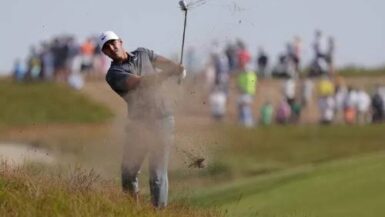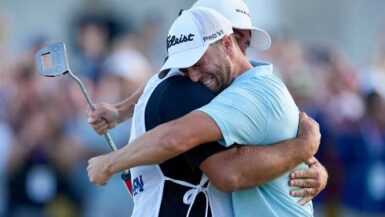OAKMONT, PA – Jerry Garcia and Robert Hunter were singing about love in the song “When the Hunter Gets captured by the Game”, but the concept applies in golf as well. For even though golf’s greatest names come loaded for bear as they hunt for one of the game’s most coveted pelts, at the U.S. Open it’s the players who come away bloodied as the golf course cuts a terrible swath through them like buckshot.
At the national championship of American golf instead of fostering an atmosphere where the players are encouraged to play creatively and aggressively, they are instead handicapped; forced into a boring, dictatorial, learned-by-heart dirge – “hit it here, then hit it here, then scrape a par.” Although we are told by broadcasters in stentorian tones that “this is the way a major should be,” there is a groundswell surging among rank and file golf fans, writers and players that the time has come to dispel that myth and improve the U.S. Open at the same time.
While some people mindlessly parrot the tired and misguided opinion that the U.S. Open – and even other majors – need to be excruciatingly difficult to truly test the games of the contestants, at one of the flagship events of American sports – wouldn’t it fair to expect more birdies, not less? Do you think more birdies would be less exciting? No, the U.S. Open has evolved from a hard test of golf become a cheerless grind; hard for hard’s sake with no rhyme or reason other than to make sure no one breaks par. We care more about the winning score than the winning player…and it doesn’t have to be this way.
For most of the year, PGA tour players are marksmen, indeed sharpshooters. Steadily they walk, stealthily they stalk; big game hunters in search of their trophy. They move with the confident aggression of an armed man; brimming with self-assurance, impeccably prepared and possessed of laser-sharp concentration. They execute with pin-point accuracy. They see a mark, they take it down, no problem.
But at the U.S. Open safari, the hunter becomes the hunted. For one week, the greens become torture chambers, sending balls slithering every which way. The rough swallows balls, the bunkers are savage and players plummet to earth as fast as names dropping off the leaderboard. If the Masters and British Open are the Serengeti Plains and Australian Outback hunt, then the U.S. Open is Jurassic Park, the animals are more likely to eat the hunters. All is quiet…then with a rustle of grass, a flash of a steely talon and a mournful wail, it’s the player who is bagged, tagged, trussed up, and sold to the butcher.
With fabled Oakmonster as this year’s host, the usual river of talk of “the course is the star” and “hardest open ever” has turned from its usual gurgling stream to a free-flowing confluence as mighty as the Allegheny, the Monongahela and the Ohio. This year we are told is “perhaps the hardest Open ever.” “But it seems every year that we’re told ‘this is the hardest Open ever'” notes Sports Illustrated columnist John Garrity sadly. “And difficulty does not equal greatness.”
Indeed, the Masters is still the greatest tournament in the world because the course design encourages players to give in to temptation. The thrill of an eagle just within reach but the danger of a double bogey lurking right behind like its evil doppelganger makes names shoot up and down like fireworks. The back nine at Augusta allows players to make a move. By succeeding or failing at that borderline, tempting shot – the difference between making a 3 or a 6 – the Masters fosters an exciting synergy of romance, tragedy, and triumph. The Masters is swashbuckling excitement.
Conversely, at the U.S. Open temptation is all but eliminated. It’s almost as if the USGA not only wants to dictate what score will win, but what type of shot must be played. Geoff Ogilvy even famously quipped along the lines that if he only played PGA events, he’d only get good at the 60 degree lob wedge.
Now all year we’ve been told it’s Johnny Miller’s fault – and believe me, Miller would love for the myth to be further proliferated, but it’s just bunk that his 63 was the impetus. It didn’t help, that’s true, but the seeds were sewn more than fifty years ago.
In 1950 the USGA started to secure more rigid control over course set up. They standardized fairway width according to the difficulty of the hole, the height of the rough according to the type of grass, and the speed of the greens to be consistent from hole to hole. That way the course would play consistently that week and each year, there would be a blueprint for making the championship consistent each time the event was contested.
Now in 1951 Robert Trent Jones redid Oakland Hills for the U.S. Open. The course was so penal – so wasp-waisted, rough-grown and some say unrecognizable from Donald Ross’ masterpiece – that Ben Hogan called the course a “monster.” Things didn’t get any better. In 1953, Oakmont played so penal that Cary Middlecoff, already known for his temper withdrew from the tournament in spectacular fashion. Well out of contention and playing the tenth hole, he deliberately hit the ball over the green and into the Pennsylvania Turnpike. “Some people swear they saw it go into the back of a truck and head off who knows where down the highway; a six hundred mile shot!” reminisced one irreverent sportswriter.
The horror stories continued. Inverness, in ’57, Winged Foot in ’59, Congressional in ’64 – the U.S. Open was murder long before Miller. Miller’s 63 was simply the last straw. But the by-product of the search for consistency and a tough test was the birth of the misguided “harder is better, faster greens are better” mantra. Nothing has ruined more member courses in this country and raised maintenance expenses so needlessly. It cannot and must not be lionized. “Too fast” greens mean less contour you can use and loss of some interesting pin positions. There is such a hue and cry that the tree removal at Oakmont brought the course back to what it looked like in 1904, but to truly bring it back to what it played like in 1904, the greens should stimp in single digits.
But here is the kicker. This is the national championship and we seek to suppress scoring? We don’t raise the hoop, broaden the paint, and call more traveling and ticky-tack fouls in the NCAA Championship game, do we? At the World Series, we don’t suddenly move the mound closer, the bases further away, move the foul poles closer together and mandate “we want the winning score to be 2-1”, do we? We don’t stop calling pass interference and narrow the football field so that no one scores 55 points in a Super Bowl ever again, do we? Of course not, that would be the height of folly and the hatcher of such a hare-brained scheme would be tarred, feathered and dragged though the streets in chains. But in golf, we are preconditioned and afraid of change. People are actually getting less excitement for their dollar than at any other major sporting event all because people don’t question the ridiculous mantra of “harder is better.”
Let’s be quite plain – is there a major sporting event with less electricity? Most people thought the Steelers – Seahawks Super Bowl was boring as it was marred by penalties, lousy punts, missed field goals and incomplete passes. 0-0 soccer games have all but condemned the game to death in America. Hockey has not resurrected itself partly because people want to see goals, not skating in circles, but that is exactly what the Open has become; skate in these circles, don’t fall through the ice.
“For one week, I like seeing the pro struggle like I do” said one fan, but you know what? Not at the national championship, the height of the season and the celebration of crowning a king. At the Super bowl, World Series and other sporting championships we are watching players succeed and ascend to the pinnacle because they are able to show us the talent that made them beat everyone else in the first place. But at the U.S. Open, we get to watch them play the USGA’s obstacle course and survive to be last man standing. If I want to watch guys stub chips, shoot 82 and three-jack all day, I’ll bring my camcorder along next time my lunkhead golf buddies play on the weekend. See how many hits that gets on YouTube.
“When you trick up the course, you get weird winners” observed veteran sportswriter Art Spander. “It’s become an incredible grind and it rewards guys like Simpson and Janzen.” Spander puts his finger on just one of several flaws in the doctrine. While Johnny Miller ridiculously rhapsodizes that “the U.S. Open is the hardest major to win,” he completely ignores that it’s the easiest to back into.
Spander continued, noting with conviction that “The Masters was the U.S. Open this year and people complained it was not as exciting. But what sometime goes unnoticed is that we change par. There was no need to reduce Oakmont’s 71 to 70. All that does is change the numbers, not the aggregate.”
Spander is spot on. One important factor is lost in all the discussion about the winning score in relation to par – the aggregate winning score. So long as the winning score hovers around 279, or (Heaven forbid!) stays clear of the major championship aggregate scoring record, does it really matter whether the winning score is 1-under par or 5-under or even 9-under? Are the members at Augusta crying a river every time 12-under wins their tournament? No, the aggregate is still 276 – an entire eleven shots clear of David Toms’ record of 265.
By keeping par at 71 – not 70 – you have no effect on whatever the aggregate winning score is. But the patrons will feel as though they saw more birdies and therefore have a more exciting tournament experience. It’s sleight of hand that’s fiendishly clever in its intricacy. The players look a little better, the fans go away happier and the members get to rave about how, yet again, the course stood up to the best in the world – from an aggregate scoring perspective.
But sadly, some people still parrot the tired argument about how “it’s nice to see the pros squirm.” Thus, the U.S. Open is not about how many birdies you get – its how many bogeys you avoid. How exciting is that? All the movement is downward with only a little percolation as players bob to the top like corks before taking on water again. As one Golf Observer writer noted, “they try to separate the great from the merely pretty good, then end up awarding the trophy to the merely pretty good.”
Sadly, the fans suffer just as much as the players. Tickets to the U.S. Open frequently surpass $100. Yet nobody is under par – often because a par 72 course is played as a par 70. “Nobody’s under par except the winner and that’s the way it should be” we are instructed…indeed indoctrinated. Now some golf fans think it’s a good idea simply because they are told it on television. That’s a hangover we don’t deserve.
The only reason we tolerate it is because like a video replay, we do what they say. We see it on TV, we parrot it without question. That’s just downright un-American. In our “we can do anything,” on-demand society we are being sold a product that could be vastly improved, yet we mindlessly regurgitate that we like it because a guy on TV told us to like it without analyzing whether it was wrong from the beginning. Therefore at the flagship tournament in America we get a mere a cheese-paring scrap of birdies. That’s un-American too.
Like the greek myth where Zeus turned hunter Acteon into a stag and he was killed by his hounds, so to does the USGA release the hunters into a the wild to be torn apart. They do it for sport and we are told how great it is, but what’s the point? Even the sturdiest of ships can’t sail in the face of wind and tide. But it doesn’t have to be that way.
Back in ’80 Baltusrol Manager MarkDeNoble said “everybody was happy with Nicklaus’ record 272. It was a tribute to the preparation that had been put into the course.” If that attitude were proliferated so that just a little cushion were allowed, the tournament would be so much more exciting. But no, it’s the fans who’ll cheer the least this week. Indeed, cheers are few and far between compared to the other 51 weeks in the golf calendar. Augusta? It’s “roaring on the pines.” The U.S. Open? With minus-1 or even-par winning, it’s pained groans and golf claps. It’s restrictor-plate racing for golf. Patrons, taut with anticipation, waiting to explode into gleeful ecstasy, more often see their hopes – so tantalizingly close – dashed away in the curl of a sharply breaking six-footer. We wait for the lightning bolt that almost never strikes.
If golf is to mirror life, then virtue must be rewarded, but what virtues are rewarded at an open? Courage? Certainly not. Wisdom? Yes Fortitude? Yes and temperance as well. Courage, however, is rarely rewarded. And that’s definitely un-American.





a Garcia-Hunter reference to kick off a golf article? wow, that’s gotta be a first. you oughta sign up for those seminars at UMass about the GD & American Culture. Jerry & Golf? I’d a never thunk it possible!
[…] Tom Fazio also had some interesting comments in my Masters preview piece, which will be up soon at PGA.com with more in the Cybergolf article. In the meantime, you’ll see I said exactly the same thi8ng Huggan said right here at last year’s U.S. Open preview and in my Masters wrap up. […]